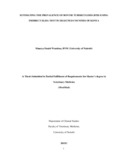| dc.contributor.author | Muasya, Daniel W | |
| dc.date.accessioned | 2015-08-31T06:29:02Z | |
| dc.date.available | 2015-08-31T06:29:02Z | |
| dc.date.issued | 2015 | |
| dc.identifier.uri | http://hdl.handle.net/11295/90233 | |
| dc.description.abstract | Bovine tuberculosis (BTB) is an important zoonotic disease whose eradication has proved
problematic due to the challenges in effective screening and diagnosis. A study to determine
the presence and prevalence of bovine tuberculosis antibodies in seven Counties of Kenya was
carried out between August and December 2013.
The study used sera that were collected from seven counties in Kenya between 2011 and
August 2013 and stored at the Central Veterinary Laboratories (CVL), Kabete Nairobi. The
samples were sorted and only those with well recorded identity selected for testing. The study
utilized a newly developed antibody ELISA Kit. A total of 644 bovine serum samples were
tested using MPB70 and MPB83 recombinant proteins as capture antigens to detect the
presence of BTB antibodies. The prevalence was determined as a proportion of the positive
samples out of total samples tested and the data were exported to SPSS 16.0 version for
analysis. Descriptive statistical analysis were then done to determine the proportions and
distribution across the counties. Graphs and charts were drawn using Microsoft excel.
The study showed a prevalence of 3.57% (23/644) with Wajir County having the highest
prevalence of 4.7% (4/85) and Kilifi county having the least at 0% (0/64). On Chi-square and
Fishers exact test there was no significant association between BTB infection and the age of
animals, categorized as young (below 3 years) and old (above 3 years of age) at (P= 0.05507).
Breed and sex indicated no significant association at (P=0.4111) and (P=0.2354) respectively.
Kappa statistics for ELISA test and Tuberculin skin test (TST) showed a strong agreement for
the two M. bovis tests at K= 0.65. This study has documented the prevalence of BTB in cattle
for the first time in Kenya utilizing a more specific antibody ELISA. This method of diagnosis
presents a quicker and a cheaper way that can be complementary or an alternative to the
screening of BTB in live animals. This study also concludes that BTB is present in Kenyan cattle populations without a significant relation to age sex and breed of animals. On the basis
of these findings, this study recommends a survey of all Counties and wildlife reserves to map
out prevalence status in the whole country. It also recommends specific policy formulation on
the control of BTB in Kenya. | en_US |
| dc.language.iso | en | en_US |
| dc.publisher | University of Nairobi | en_US |
| dc.title | Estimating the prevalence of bovine tuberculosis (BTB) using indirect elisa test in selected counties of Kenya | en_US |
| dc.type | Thesis | en_US |
| dc.description.department | a
Department of Psychiatry, University of Nairobi, ; bDepartment of Mental Health, School of Medicine,
Moi University, Eldoret, Kenya | |
| dc.type.material | en_US | en_US |

